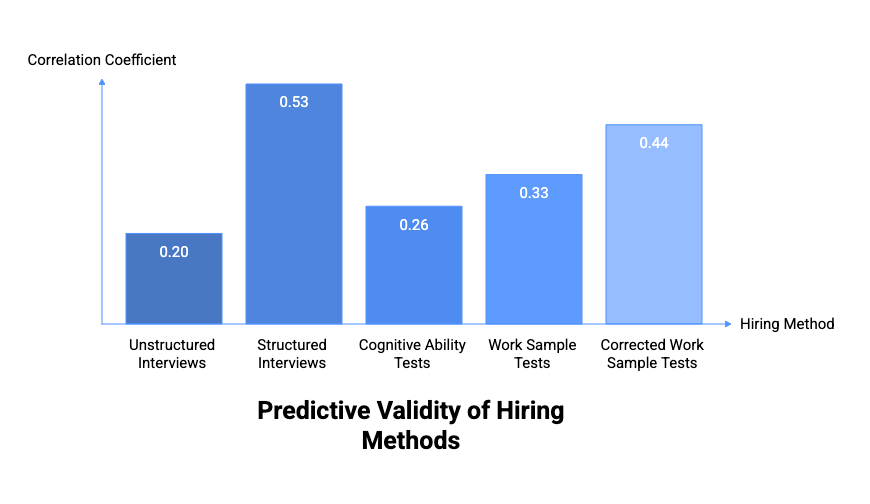Every hiring conversation typically starts with that gut feeling, when someone just clicks. But research paints a very different picture. Multiple studies reveal that unstructured interviews, those open-ended chats where questions vary, have predictive accuracy barely above chance, explaining just about 14–20% of job performance.
That means charisma and first impressions can easily overshadow actual competence, while unconscious biases go unchecked. So, what’s the alternative? This article shows you how to combine human insight with solid data.
You’ll discover how structured interviews, scored with rubrics, and objective assessments like work samples and cognitive tests, offer stronger and fairer hiring predictors.
We’ll walk through why intuitive hiring alone falters, the benefits of adding structure and metrics, and practical steps to build a recruitment process that enhances intuition, not eliminates it, by grounding it in evidence.
Key Takeaways
- Gut instinct is unreliable — unstructured interviews and intuition have the lowest predictive validity when it comes to hiring success.
- Structured approaches outperform — structured interviews, work sample tests, and cognitive assessments provide stronger signals of future performance.
- AI and analytics scale decisions — predictive models can cut hiring time dramatically (as seen in Unilever’s 4-month to 4-week shift) while processing huge applicant volumes.
- Human oversight remains essential — without checks, algorithms can reinforce historical biases; fairness audits and demographic monitoring are critical.
- Fairness frameworks drive inclusion — intentional measures like the “Rooney Rule” ensure diverse candidate slates and better organizational outcomes.
- The business case is clear — data-driven hiring not only improves accuracy but also reduces costs, saves recruiter hours, and enhances diversity and culture.
Why Gut Feel Alone Falls Short?
Most of us have been in interviews where a candidate just “feels right.” The problem is, research shows those instincts don’t translate well into actual performance. In fact, unstructured interviews only predict job success about 14–20% of the time, not much better than a coin toss.
And when the wrong person is hired, the cost isn’t just financial. Beyond the 30–40% of annual salary it takes to replace them, there’s the disruption to the team, the lost time for managers, and the dip in morale that comes with admitting a hire didn’t work out.
Unchecked Bias and Inconsistency
Gut decisions create a breeding ground for unconscious bias, based on gender, ethnicity, or personality traits, because they lack structure and repeatability. Worse, they offer no audit trail or metrics for accountability.
Poor Accountability and Learning
When hiring is based on intuition alone, it’s difficult to analyze what worked or failed. Organizations lose valuable opportunities to learn and continuously improve their process.

The Power Of Data‑Informed Recruitment
Moving to data-informed hiring transforms your recruitment approach from gut-based guesswork to a system rooted in measurable insights.
Structured interviews, standardized assessments, and analytics aren’t just buzzwords; they consistently deliver significantly better predictions of job success, reduce bias, and speed up hiring, all while enhancing fairness and clarity in decision-making.
Structured Interviews: The Gold Standard
In structured interviews, every candidate is asked the same, job-related questions and scored with a clear rubric. This consistency makes them far more reliable than unstructured interviews.
Research shows they can be three to five times better at predicting future performance. While unstructured interviews are only slightly better than chance, structured formats deliver much stronger accuracy.
Pre‑Employment Assessments & Work Sample Tests
Objective tests, like cognitive assessments and work samples, consistently outperform unstructured interviews.
Work samples, in particular, give one of the clearest signals of future success because they let candidates demonstrate the actual skills needed on the job.
Improving Diversity With Data Analytics
Using recruitment analytics to monitor demographics, funnel ratios, and sourcing channels helps uncover bias and promotes fairer hiring outcomes. Structured tools and algorithmic screening can reduce bias, but only when supported by transparent oversight.
Faster, More Cost‑Effective Process
Data-driven hiring cuts time-to-hire and cost per hire while illuminating bottlenecks in your recruitment funnel. Though it demands upfront investment, the long-term return includes reduced turnover and stronger performance alignment.
Steps To Blend Intuition With Data
Combining gut instinct with data-driven methods creates a well-rounded hiring process, one that taps into human intuition while anchoring decisions in evidence.
Key strategies include defining clear role criteria, employing structured interviews with consistent scoring, and validating intuitive impressions through objective assessments and diverse perspectives.
Step 1: Define Role Benchmarks & Key Metrics
Start with a job analysis: list required competencies, behavior indicators, and success outcomes. This guides question development, assessment design, and performance alignment.
Step 2: Build Structured Interviews
- Use behavioral, situational, and competency-based questions aligned with job requirements.
- Ask all candidates the same questions in the same sequence.
- Score responses using anchored scales (e.g., 1–5). Research shows this enhances inter-rater reliability and scoring consistency.
Step 3: Add Objective Assessments
- Cognitive tests and work samples give quantitative insights into core abilities.
- Personality measures can add context if roles require emotional intelligence or resilience.
Step 4: Preserve Cultural Fit, Verify with Evidence
Allow hiring managers to rise to the surface naturally, but validate gut impressions with data. If a candidate feels like a cultural match, probes, tests, or references can confirm or challenge that belief .
Step 5: Train Interviewers & Calibrate Scores
Provide bias training, scoring workshops, and regular calibration sessions. Structured interviewing only works if consistently applied.
Step 6: Track Performance & Iterate
Collect data on new-hire performance, retention, promotion rates, and feedback. Compare against initial scores, refine rubrics, and update assessment tools over time.
Case Study: Sales Team Transformation
Companies across industries are increasingly showcasing how data-driven hiring transforms outcomes, delivering faster processes, fairer evaluations, and measurable impact.
The examples below demonstrate how leading organizations like Chipotle and Unilever have harnessed AI, structured assessments, and analytics to improve efficiency, diversity, and quality in their recruitment.
A mid-sized SaaS company shifted from gut-based sales hiring to a structured, data-first approach:
Chipotle & “Ava Cado” AI Assistant
When Chipotle needed to bring on 20,000 seasonal workers, its traditional hiring process couldn’t keep up. By introducing Paradox’s AI assistant “Ava Cado,” the company made applications easier to complete and automated scheduling.
The impact was immediate: completion rates jumped from 50% to 85%, and time-to-hire fell from nearly two weeks to just four days. It’s a clear example of how automation can speed up high-volume recruitment without sacrificing candidate experience.
Unilever’s AI‑powered Talent Assessment
Unilever saved 50,000 hiring hours while also boosting diversity by replacing resume screening with neuroscience games and AI video assessments. The process shrank from four months to just four weeks.
What this shows: Replacing traditional screens with structured tech tools drives both speed and inclusion.
Marriott International’s Gamified Screening
In collaboration with Pymetrics, Marriott introduced gamified cognitive and emotional assessments to screen candidates.
This innovation reduced drop-off in early stages, improved candidate quality, and significantly lowered turnover in roles where fit mattered, including frontline hospitality.
Walmart’s Predictive Analytics Overhaul
Walmart applied machine learning to historical hiring and performance data to redesign its recruitment funnel. The result: a 40% reduction in time-to-hire and a 20% improvement in retention, showcasing the power of predictive modeling in high-volume hiring environments.
Why These Case Studies Matter?
These case studies highlight how leading organizations use data-driven hiring strategies to achieve faster results, enhance diversity, and improve employee retention.
For example, AI-powered tools that screen candidates objectively have lifted offer acceptance rates and bolstered inclusion, key factors linked to stronger innovation, performance, and employee engagement.
| Benefit | Why It’s Valuable |
| Scale & speed | Chipotle and Unilever dramatically enhanced throughput for large-scale hiring. |
| Fairness & diversity | AI-powered assessments helped reduce bias by focusing on skills and behavior. |
| Quality hires | Marriott and Walmart saw clear gains in retention and job performance. |
| Efficiency gains | All companies cut time-to-hire and operational costs measurably. |
Advanced Techniques And Ethical Considerations
As hiring processes integrate advanced tools like AI-driven interviews, predictive analytics, and algorithmic screening, companies gain efficiency, but they also face complex ethical challenges around fairness, transparency, and privacy.
Addressing these concerns requires more than accuracy; it demands robust oversight, ensuring diverse training data, clear candidate consent, explainable algorithms, and ongoing audits to prevent bias and uphold trust.
AI & Predictive Analytics
AI systems, like the one Unilever used to handle over 250,000 applications, can speed up hiring dramatically, cutting timelines from months to weeks. But while these tools save time, they need human oversight to avoid reinforcing past biases.
But blind trust in AI risks reinforcing bias; human oversight remains critical to avoid perpetuating inequalities.
Why It Matters:
- Makes it easier to spot strong candidates quickly
- Can cut hiring timelines dramatically. Unilever went from four months to just four weeks
- May unintentionally reinforce old patterns if not carefully checked
- Works best when balanced with human oversight and context
Multiple Mini Interviews (MMI)
The “Multiple Mini Interview” (MMI) approach breaks interviews into several short, structured conversations, each focused on a specific skill or trait. Studies show this format is fairer, more consistent, and better at predicting future performance than traditional interviews.
Why It Matters:
- Short, focused interviews give a more reliable picture of candidate strengths
- Reduces the risk of one bad interview unfairly hurting a candidate’s chances
- Helps hiring teams compare candidates more consistently
- Research shows it does a better job of predicting long-term performance than traditional formats
Fairness & Inclusion
To keep hiring fair, companies should track demographic data, audit their systems regularly, and check that algorithms rank candidates without bias.
Following a Rooney Rule–style approach, making sure underrepresented groups are always part of the candidate pool, can strengthen both fairness and overall business performance.
Why It Matters:
- Tracking demographic data across the hiring funnel helps spot gaps early
- Fair-ranking algorithms can open doors for underrepresented candidates
- Regular audits keep the system honest and accountable
- Following approaches like the Rooney Rule can drive a more diverse, innovative workforce
Balancing Data And Intuition
The best hiring decisions emerge from a synergy of data-backed insights and well-tuned intuition. Think of data as the compass; it outlines trends, flags anomalies, and assesses candidate fit through structured metrics.
Intuition, honed by experience and domain knowledge, then acts as the human lens, interpreting subtleties, cultural fit, and unforeseen potential. Harvard research confirms that decision-makers combining both outperform those relying solely on data or instinct.
To achieve this balance, organizations should:
- Validate Intuition with Data: Encourage interviewers to check gut impressions against objective scores and test results before finalizing decisions.
- Use Intuition to Identify Data Gaps: When traditional metrics fall short, rely on intuition to highlight areas needing deeper analysis, such as leadership potential or adaptability.
- Foster a Collaborative Culture: Promote dialogue among diverse teams where both data analysts and seasoned recruiters contribute, ensuring multiple lenses inform critical hiring decisions.
- Develop “Data-Informed Intuition”: Regular exposure to hiring analytics sharpens instinct over time, making gut reactions more reliable.
By treating data as a guide and intuition as a refined check, hiring leaders can navigate complexity with confidence, making more nuanced, fair, and effective decisions.
Conclusion
Transitioning to data-driven hiring doesn’t discard intuition and sharpens it. Grounding your gut sense in structured methods enhances fairness, curtails bias, and consistently produces superior hires.
By combining structured interviews, objective assessments, analytics, training, and ongoing iteration, organizations build a recruitment engine that’s both transparent and effective.
This balanced approach ensures candidates are evaluated on true performance predictors, not charisma or unconscious bias. It also fosters trust among internal stakeholders and protects the candidate experience through accountability and clarity.
In essence, data-informed intuition empowers hiring teams to make nuanced decisions with confidence, cultivating more equitable, capable, and diverse workforces.









